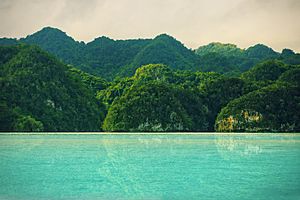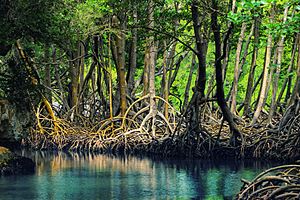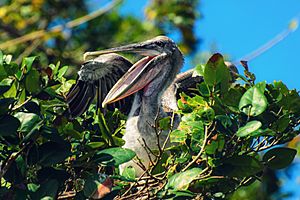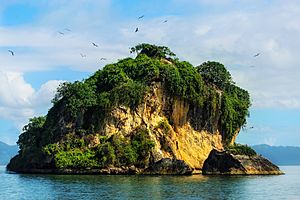Los Haitises National Park facts for kids
Los Haitises National Park is a special natural area located on the remote northeast coast of the Dominican Republic. It was created in 1976 to protect its unique environment. The park is known for its amazing landscape, which includes tall, cone-shaped limestone hills, deep holes called sinkholes, and many hidden caves. A large part of the coast is covered by mangrove forests, which are special trees that grow in salty water. Other areas of the park are dense, humid forests. The park gets a lot of rain, about 2,000 millimeters (79 inches) each year.
This park is home to many different kinds of animals and birds, including some rare species found only on this island. Inside some of the caves, you can find ancient drawings and carvings made by early people. Los Haitises has become a popular place for ecotourism, which means visiting nature in a way that protects it. However, only a limited number of tourists are allowed to visit to keep the park safe.
Contents
History of Los Haitises Park
Los Haitises National Park was officially created on June 3, 1976. Before it became a national park, this area was known as the "Los Haitises Prohibited Zone," a forest reserve. In 1996, the park's size was greatly expanded from 208 square kilometers (80 square miles) to 826 square kilometers (319 square miles).
Most of the park is located in the town of Sabana de la Mar, which is in the Hato Mayor Province. Parts of the park also stretch into the Monte Plata Province and Samaná Province. Sabana de la Mar is where you can find a special center for visitors. Even though some trees have been cut down in the past, the park still receives a lot of rain, usually between 1,900 and 2,000 millimeters (75 to 79 inches) every year. This makes it one of the rainiest places in the Dominican Republic.
Geology and Landscape of Los Haitises
The unique landscape of Los Haitises was formed millions of years ago during the Miocene period. It is a type of karst landscape, which means it has many limestone hills that are almost the same height, usually between 200 and 300 meters (656 to 984 feet) tall. Between these hills, there are many sinkholes, which are natural holes in the ground.
This special landscape stretches about 82 kilometers (51 miles) from east to west and 26 kilometers (16 miles) from north to south. The hills you see inside the park were formed in the same way as the small islands in the nearby Samaná Bay. The park also has many, many caves.
Water plays a big role in Los Haitises. The park includes parts of two major river systems. In the western half, you'll find the lower part of the Yuna River. In the eastern half, there are areas near the towns of Miches and Sabana de la Mar. The Yuna River flows into the sea through two mouths. Other rivers like the Payabo River and the Los Cocos River also flow through the park, along with many natural water channels.
Plant Life in Los Haitises
Los Haitises National Park is home to two main types of forests: humid subtropical forest and very humid subtropical forest. These forests are filled with many different kinds of broadleaf trees. Some of the common trees you might see include "musk wood" (called cabirma santa locally), cigar-box cedar, ceiba, and West Indian mahogany. You can also find many different types of orchids growing here.
One of the most important plant features of Los Haitises is its large amount of Caribbean mangrove forests. Mangroves are special trees that can grow in salty water along the coast. The most common types of mangroves in the park are red mangrove and white mangrove. These mangrove forests are very important for the health of the coastal environment and provide homes for many animals.
Animal Life in Los Haitises
The animal life in Los Haitises National Park is incredibly diverse. Because the park has so many different types of environments, it has more different kinds of animals than any other protected area in the Dominican Republic.
Two special mammal species that are found only on the island of Hispaniola live here, and they are both in danger of extinction. These are the Hispaniolan hutia and the Hispaniolan solenodon.
Since Los Haitises is a coastal and marine park, it is also home to a huge variety of birds. Many of the bird species found only in the Dominican Republic live here. These include the brown pelican, the magnificent frigatebird, and the Hispaniolan amazon. You might also spot owls like the barn owl and the stygian owl. The park is especially important because it has the largest population in the world of the Ridgway's hawk, a rare bird found only on this island.
Visiting Los Haitises National Park
Los Haitises National Park is a protected natural area with very few roads. To help protect the park, only a limited number of tourists are allowed to visit. However, since the year 2000, it has become a popular place for ecotourism. This means people visit the park in a way that respects and protects nature, often with local guides from Sabana de La Mar.
The word Haiti (singular) comes from the Taíno language, meaning "highland" or "mountain range." Even though the hills in the park are not very tall (ranging from 30 to 40 meters or 98 to 131 feet), they are still a significant feature. The park is famous for its many caves, which were formed by water slowly eroding the rock over time. Inside these caves, you can find ancient drawings called pictographs and carvings called petroglyphs made by early Native Americans. We don't know exactly which cultures created all of these artworks, and some might even be older than the Taíno people.
Los Haitises National Park offers amazing views, including the beautiful San Lorenzo Bay, many small islands (called keys), and the dense mangrove forests. One special spot is Cayo de los Pájaros, or "Bird Key." This island is famous for the many frigatebirds and pelicans that are always flying overhead. The cupey tree is very common here, and birds often rest on its wide, flat branches. Other trees you might see include the wild banyantree and the tropical almond.
Most visitors arrive at the park by boat. You can take a boat from Sabana de la Mar (on the east side), Sánchez (on the north side), or Samaná (which is across Samaná Bay from Sabana de la Mar). It is also possible to reach the park by land from the south using four-wheel-drive vehicles. New roads and an airport are being built in Samaná to make it easier for people to visit.
See also
 In Spanish: Parque nacional Los Haitises para niños
In Spanish: Parque nacional Los Haitises para niños





